Ready, set, go!
In Conditions
Follow this topic
Bookmark
Record learning outcomes
Physical activity is one of the most powerful health interventions there is, and while it's always been there as an option, it's often not taken advantage of. So, what do pharmacy teams need to know to encourage their customers to get up and get active?
Exercise has been on lots of people’s minds over the last few months. Even if they weren’t exactly fitness fanatics before the Covid-19 pandemic, being cooped up at home for weeks and months on end has made lots of people reassess their approach to physical activity.
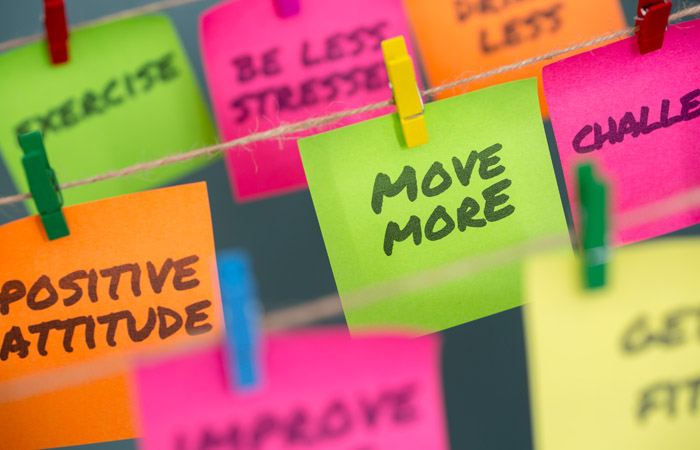
Lockdown has given the nation a love of at-home workouts and proved that no one necessarily has to have fancy equiptment, a lot of time or even to leave the house to get active.
Getting out for a daily walk or run, doing an online fitness class or taking advantage of having more time to do gardening – there’s something for everyone, whatever their age, ability and preferences. Exercise may seem daunting, but it doesn’t need to be a chore, nor does it have to be particularly intensive – the key is to just get moving regularly.
The couch potato cost
Sedentary lifestyles are becoming the norm for vast swathes of the population, as ‘the Netflix generation’ curls up on the sofa to binge-watch boxsets or play video games, people choose the car or public transport over active forms of travel, and office – or more recently home – workers spend their days hunched over a computer. In fact, office workers can spend as much as 80 per cent of the working day sitting down, and that’s before considering time spent sitting on the commute or relaxing in the evenings. The chair being sat on might change, but the position is the same and that position can cause problems.
The ‘Get Britain Standing’ campaign estimates that the average person spends 8.9 hours a day seated. Evidence suggests that sitting for more than four hours each day can lead to things such as reduced calorie burning, disrupted blood sugar levels, increased blood pressure and leg muscles switching off. Irrespective of physical activity levels, the result leads to increased risk of obesity, heart disease, type 2 diabetes, cancer, back and neck pain, dementia, depression, osteoporosis, muscle degeneration and mortality.
Almost 70,000 deaths per year in the UK are at least partly attributable to prolonged sitting down, according to research published in the Journal of Epidemiology and Community Health. This is why sedentary behaviour has been described by the Department of Health and Social Care as a “silent killer”. In addition to this personal health cost, there’s also a significant burden placed on the NHS, with sedentary behaviour costing around £700 million per year – a significant amount of money to be spent on something that’s almost entirely preventable.
Not all doom and gloom
Intense pressure on the NHS, ill health and reduced life expectancy sounds rather dismal, but there is hope. According to the UK chief medical officers’ physical activity guidelines report – last updated in January 2020 – the message is clear: “If physical activity were a drug, we would refer to it as a miracle cure, due to the great many illnesses it can prevent and help treat.”
Regular physical activity can improve muscle strength, help the cardiovascular and respiratory systems work more efficiently, improve sleep quality, boost self-esteem and increase energy and stamina. And that’s just scratching the surface of the benefits.
According to the NHS, it can reduce people’s risk of major illnesses, such as heart disease, stroke, type 2 diabetes and cancer by up to 50 per cent and lower people’s risk of early death by up to 30 per cent. Now that’s worth getting up for.
Breaking down barriers
While there’s overwhelming evidence in support of exercise, many people will delay it or avoid it altogether for a variety of reasons, including body pain and arthritis. But resting for long periods may actually make the pain worse.
According to the charity Versus Arthritis, exercise is one of the best things someone can do to improve their symptoms. Their advice is: “If you have joint pain, start gently and gradually increase the length of time you’re exercising. You can break this into smaller chunks if you need to. Doing five to 10 minutes of exercise each day is important to keep your joints moving and your muscles strong.”
The bottom line is, everyone needs to take exercise in their stride and find an activity they feel comfortable doing. Whatever this is, the advice is for people to start slow, listen to their body and gradually build up, otherwise they will be more prone to injury and potentially do more harm than good.
How much?
Everyone, no matter what their age, should aim to be physically active every day. Any activity is better than none and the more the better. This table shows the NHS physical activity recommendations for adults:

Putting it into practice
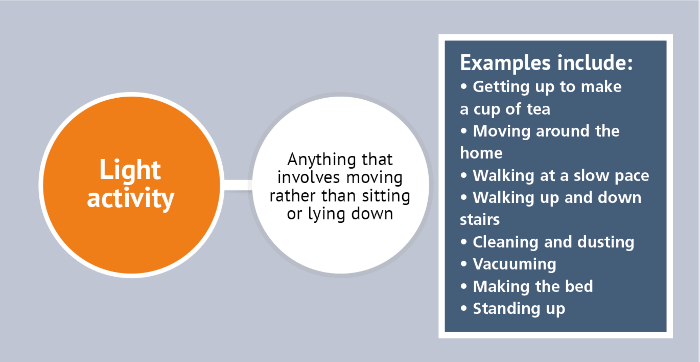
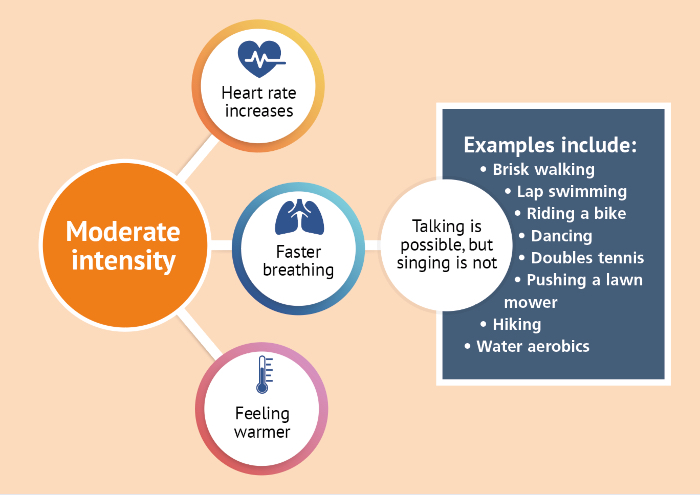
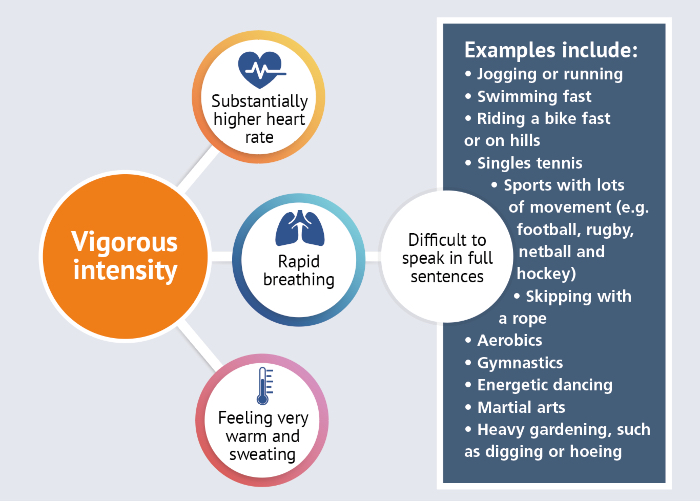
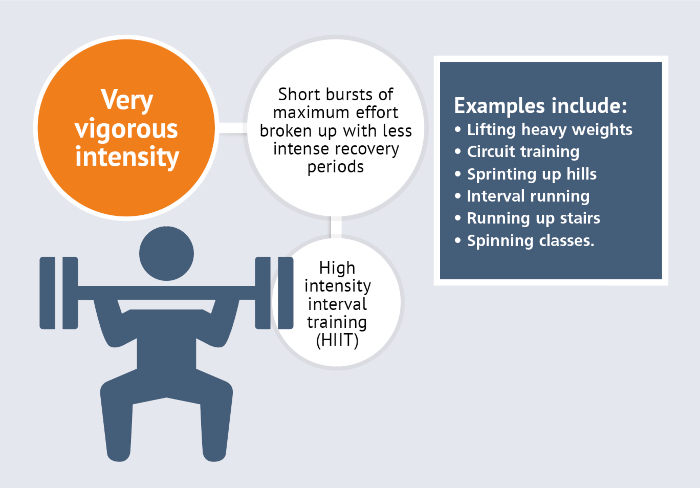
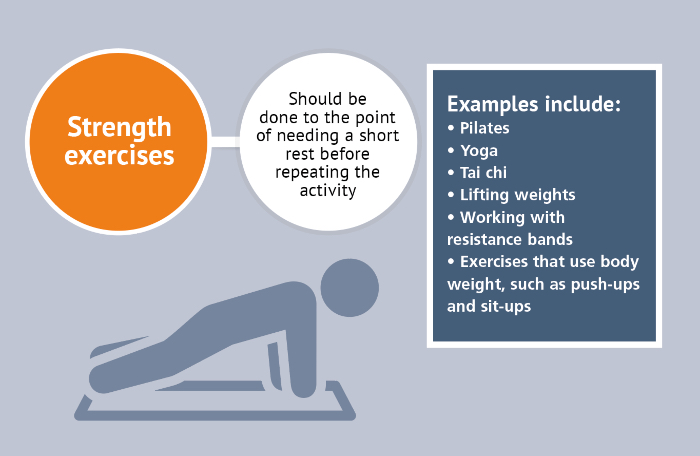
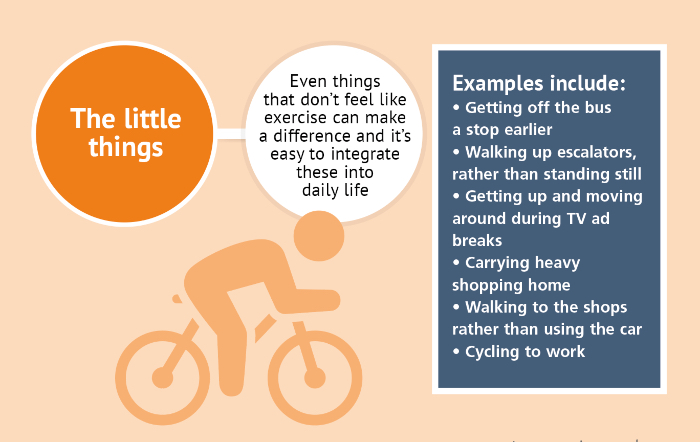
Injuries and other issues
While the benefits of exercising are extensive, there can be a risk of things going wrong. Pharmacy teams can be on hand with information and advice to help customers prevent, manage and treat common problems.
Sprains and strains
A sprain is an injury to a ligament that supports a joint. The ankle, knee and wrist are often affected. A strain is when injury happens to a muscle or tendon. Symptoms are usually pain around the affected joint or muscle, swelling and inflammation and sometimes bruising later on. If a sprain or strain occurs, pharmacy teams can advise customers to use the PRICE technique:
- Protect the injured area from further damage by using a support
- Rest and avoid activity for at least 48-72 hours after the injury
- Ice should be applied as soon as possible for at least 30 minutes to help limit swelling
- Compression should be applied by using an appropriate bandage
- Elevation of the area will help to limit the swelling.
Sprains and strains may need urgent medical attention if pain and swelling continue to increase.
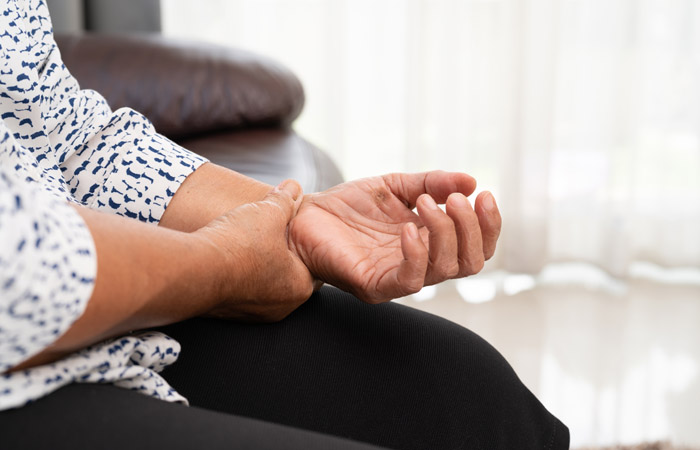
Shin splints
Shin splints are a feeling of pain and tenderness caused by too much stress on the legs, often as a result of running. It is not a serious injury and should improve after a few weeks. Pharmacy teams can advise customers to take paracetamol or ibuprofen
to ease the pain and put an ice pack on the shins for up to 20 minutes every two to three hours. Customers should cease the exercise that caused the pain and practise gentle exercise, such as yoga, on soft ground and ensure they wear appropriate footwear.
Tennis elbow
This injury happens after overuse of the muscles and tendons attached to the elbow joint, common in tennis players. Pain may be felt below the bend of the elbow, when lifting or bending the arm, when gripping objects or twisting the forearm. Fully extending the arm can also be difficult. Customers should avoid strenuous and repetitive activity until pain has reduced and, if pain persists, they should visit a GP. Pharmacy teams can advise customers to rest, take paracetamol or ibuprofen to reduce pain – the latter also helps to reduce swelling. Putting ice or a cold pack on the affected area can also help. According to the NHS, most cases of tennis elbow last between six months and two years, with nine in 10 cases making a full recovery within a year.
Dehydration
Dehydration occurs when the body has lost more fluids than it has taken in, which can become a serious problem if left untreated. Symptoms may include thirstiness, dark coloured urine, urinating less than four times a day, feeling dizzy and tired and having dry eyes, lips and mouth. The NHS recommends that people drink six to eight glasses of water a day, on average. During exercise, customers should be encouraged to up their intake of fluids as the body loses fluid through sweating. Pharmacy teams can also recommend oral rehydration sachets to help replace sugar, salts and minerals the body has lost, if appropriate. Urgent medical attention is required if any of the following red flag symptoms appear:
- Feeling lethargic
- Not urinating in eight hours
- A weak or rapid pulse
- Low level of consciousness
- Seizures.
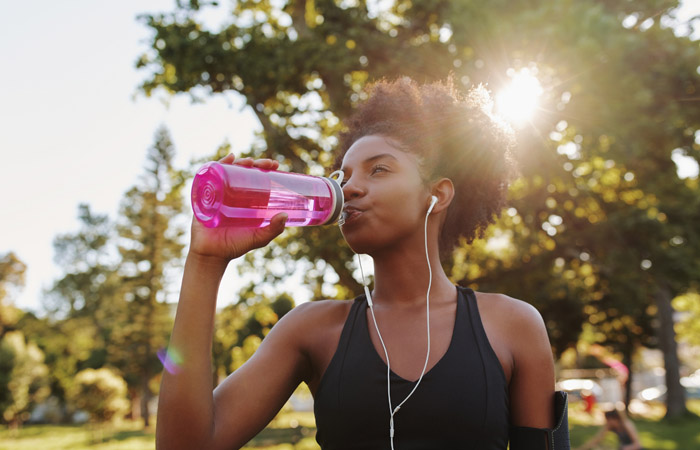
Blisters
Blisters appear as pockets of fluid under the surface of the skin and are usually caused by friction, often on the feet. Customers should be advised to take steps to stop the blister becoming infected. This includes washing hands before touching the blister, especially if it has burst, and covering the blister with a soft dressing. If the blister does burst, a plaster or dressing can be applied. Pharmacy teams should inform customers not to burst blisters themselves, as this can cause infection. Blisters should heal themselves within a week, although various products are available to protect the site of the blister as it heals. Wearing shoes that caused the blister should also be avoided until it has healed. If the skin looks infected, is hot or the blister is filled with green or yellow pus, then the customer should be advised to visit a GP.
Customers should be encouraged to wear sunscreen with an SPF of at least 30
Sunburn
Sunburn is skin damage caused by ultraviolet (UV) rays and can lead to some types of skin cancers (see our CPD module on Skin cancer and sun protection). When burnt, the skin will appear red, sore, tender, hot and even itchy for up to a week. Customers should be encouraged to wear sunscreen with a sun protection factor (SPF) of at least 30. Whilst exercising in the sun, customers should be advised to cover up with a t-shirt, wear a hat and sunglasses, drink plenty of fluids and avoid exercising at the hottest times of day. Mild sunburn can be relieved with a cooling aftersun product to help soothe the skin or, alternatively, moisturiser can be used. Customers should not use ice packs to cool the skin or scratch peeling skin. Avoiding tight fitting clothes can also help prevent additional discomfort. Sunburn can be severe and need medical attention. Customers should be referred to the pharmacist for further advice if skin is blistered or swollen, they have a high temperature, feel hot and shivery, have muscle cramps or a headache.
